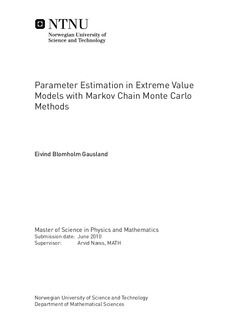Parameter Estimation in Extreme Value Models with Markov Chain Monte Carlo Methods
Master thesis
Permanent lenke
http://hdl.handle.net/11250/258568Utgivelsesdato
2010Metadata
Vis full innførselSamlinger
Sammendrag
In this thesis I have studied how to estimate parameters in an extreme value model with Markov Chain Monte Carlo (MCMC) given a data set. This is done with synthetic Gaussian time series generated by spectral densities, called spectrums, with a "box" shape. Three different spectrums have been used. In the acceptance probability in the MCMC algorithm, the likelihood have been built up by dividing the time series into blocks consisting of a constant number of points. In each block, only the maximum value, i.e. the extreme value, have been used. Each extreme value will then be interpreted as independent. Since the time series analysed are generated the way they are, there exists theoretical values for the parameters in the extreme value model. When the MCMC algorithm is tested to fit a model to the generated data, the true parameter values are already known. For the first and widest spectrum, the method is unable to find estimates matching the true values for the parameters in the extreme value model. For the two other spectrums, I obtained good estimates for some block lengths, others block lengths gave poor estimates compared to the true values. Finally, it looked like an increasing block length gave more accurate estimates as the spectrum became more narrow banded. A final simulation on a time series generated by a narrow banded spectrum, disproved this hypothesis.
